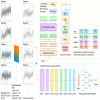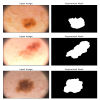Publications
2024
-
 Multivariate Time Series Classification of EEG Signals using Temporal TransformersRishit Toteja, Keshav Chauhan, Prince Shishodia, and 3 more authorsIn 2024 3rd IEEE International Conference on Power Electronics, Intelligent Control and Energy Systems (ICPEICES), 2024
Multivariate Time Series Classification of EEG Signals using Temporal TransformersRishit Toteja, Keshav Chauhan, Prince Shishodia, and 3 more authorsIn 2024 3rd IEEE International Conference on Power Electronics, Intelligent Control and Energy Systems (ICPEICES), 2024In this study, we investigate a novel approach for classifying multivariate time series EEG signals to identify Parkinson’s disease (PD), comparing Transformer models to traditional CNNs. Parkinson’s disease (PD) is a neurodegenerative disorder characterized by progressive loss of dopamine-producing neurons in the brain. Currently, a deep convolutional-recurrent neural network (CRNN) achieves high accuracy in PD detection. We introduce PaCT: a Time Series Transformer with Positional Embeddings (TST-PE), an architecture tailored for EEG signal classification. TST-PE leverages positional embeddings to capture temporal dependencies effectively which embeddings further enhance classification results. Experimental results demonstrate TST-PE’s superior performance over CNN-based approaches, achieving a classification accuracy of 96%. This work suggests Transformer models could significantly improve PD diagnosis, and extends to broader applications in preventive healthcare and brain-computer interface development.
@inproceedings{8897445, author = {Toteja, Rishit and Chauhan, Keshav and Shishodia, Prince and Pillai, Rohan and M. Kumar, Rupesh and Chaudhary, Abhishek}, title = {Multivariate Time Series Classification of EEG Signals using Temporal Transformers}, year = {2024}, volume = {}, number = {}, keywords = {Multivariate Time Series Analysis, Classification, Machine Learning, Transformer, Electroencephalogram (EEG), Parkinson’s Disease}, booktitle = {2024 3rd IEEE International Conference on Power Electronics, Intelligent Control and Energy Systems (ICPEICES)} }
2022
-
 Skin Disease Detection Using Saliency Maps and \nSegmentation TechniquesRishit Toteja, Dhruv Gupta, Vibhor Gautam, and 1 more authorIn International Conference on Computer Vision and Image Processing, 2022
Skin Disease Detection Using Saliency Maps and \nSegmentation TechniquesRishit Toteja, Dhruv Gupta, Vibhor Gautam, and 1 more authorIn International Conference on Computer Vision and Image Processing, 2022Skin diseases are among the most prevalent medical conditions globally. Detecting these diseases requires a high degree of expertise and precision from dermatologists, making computer-aided diagnosis highly beneficial. In this paper, we present an approach for detecting skin diseases that provides enhanced diagnostic insights. Several studies have been conducted to aid in the diagnosis of skin conditions, including skin cancer and tumors. However, accurate identification remains a challenge due to factors such as the visual similarity between different conditions, low contrast between lesions and surrounding skin, and the subtle differences between affected and unaffected regions. Our approach employs an image dataset that is pre-processed through deblurring, noise reduction, and enhancement techniques. Following pre-processing, the images are segmented using the U-Net architecture, and MobileNetV2 is employed for classification. The disease is detected based on distinct patterns observed in the processed images, corresponding to the dispersant characteristics of each condition. Additionally, we compute a class saliency map for each input image and its associated class. This work demonstrates how Convolutional Neural Networks (ConvNets) can be used effectively for both the classification and segmentation of skin diseases, utilizing saliency maps to improve interpretability.
@inproceedings{toteja2022skin, title = {Skin Disease Detection Using Saliency Maps and \n Segmentation Techniques}, author = {Toteja, Rishit and Gupta, Dhruv and Gautam, Vibhor and Vishwakarma, Dinesh Kumar}, pages = {328--340}, year = {2022}, organization = {Springer}, booktitle = {International Conference on Computer Vision and Image Processing} }